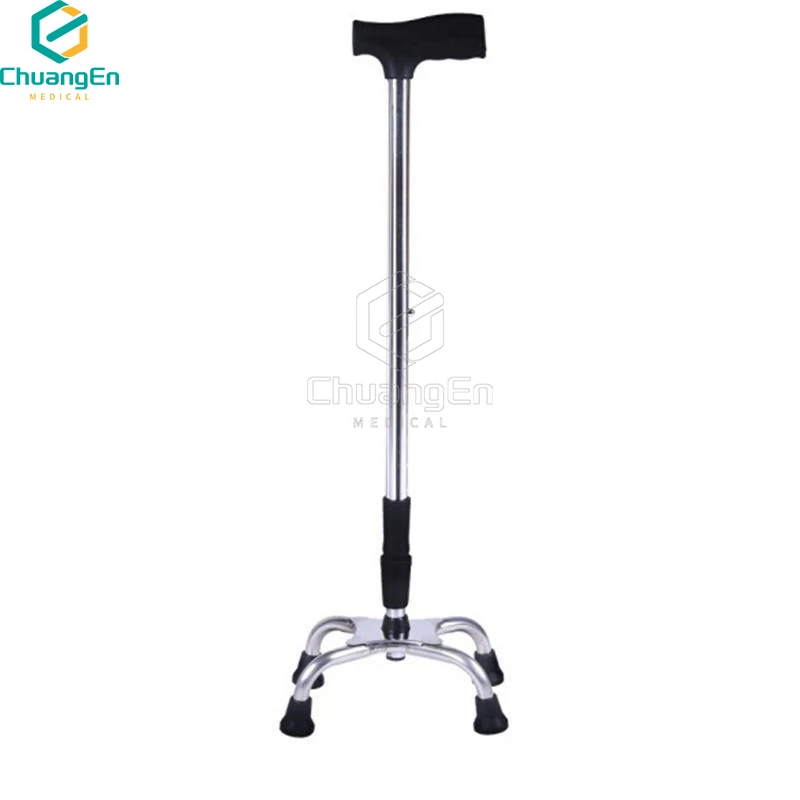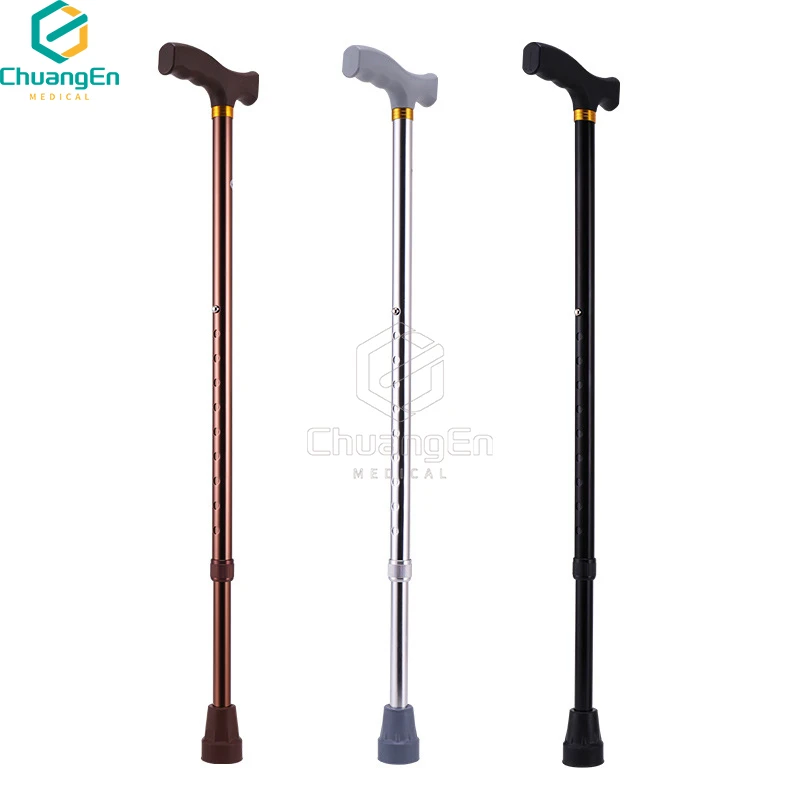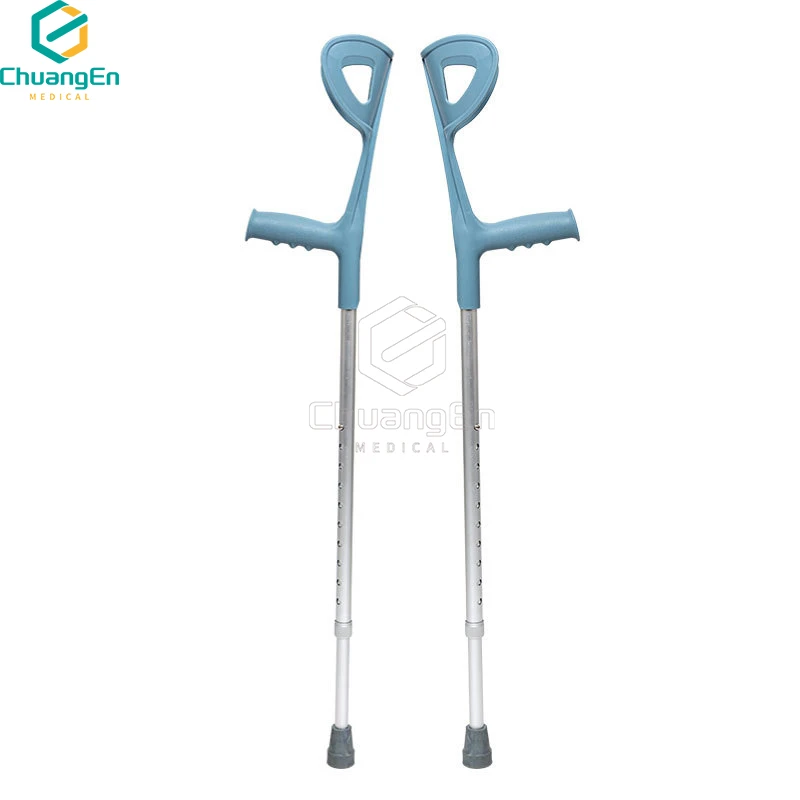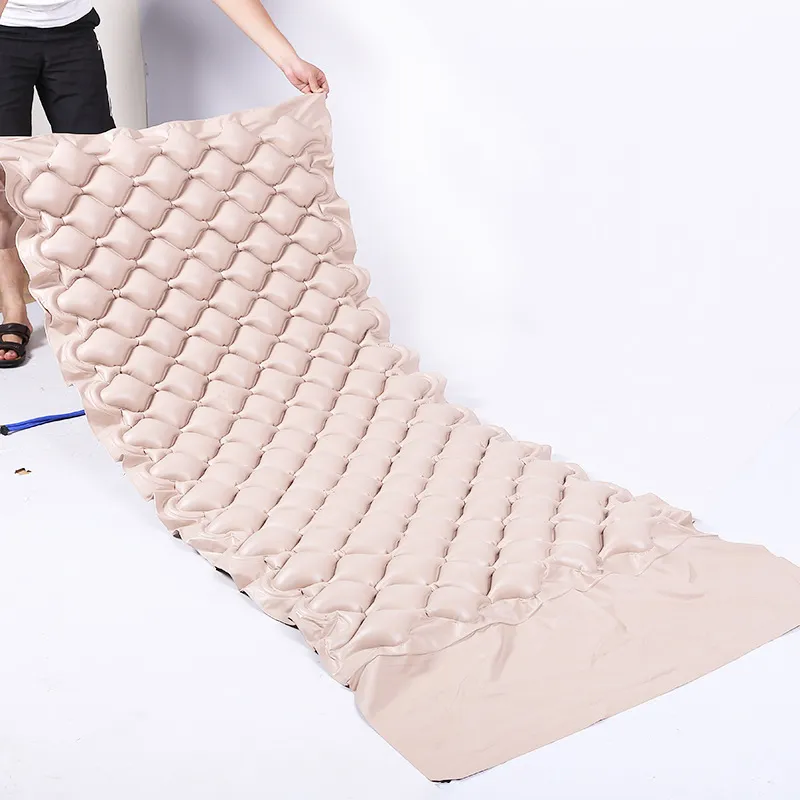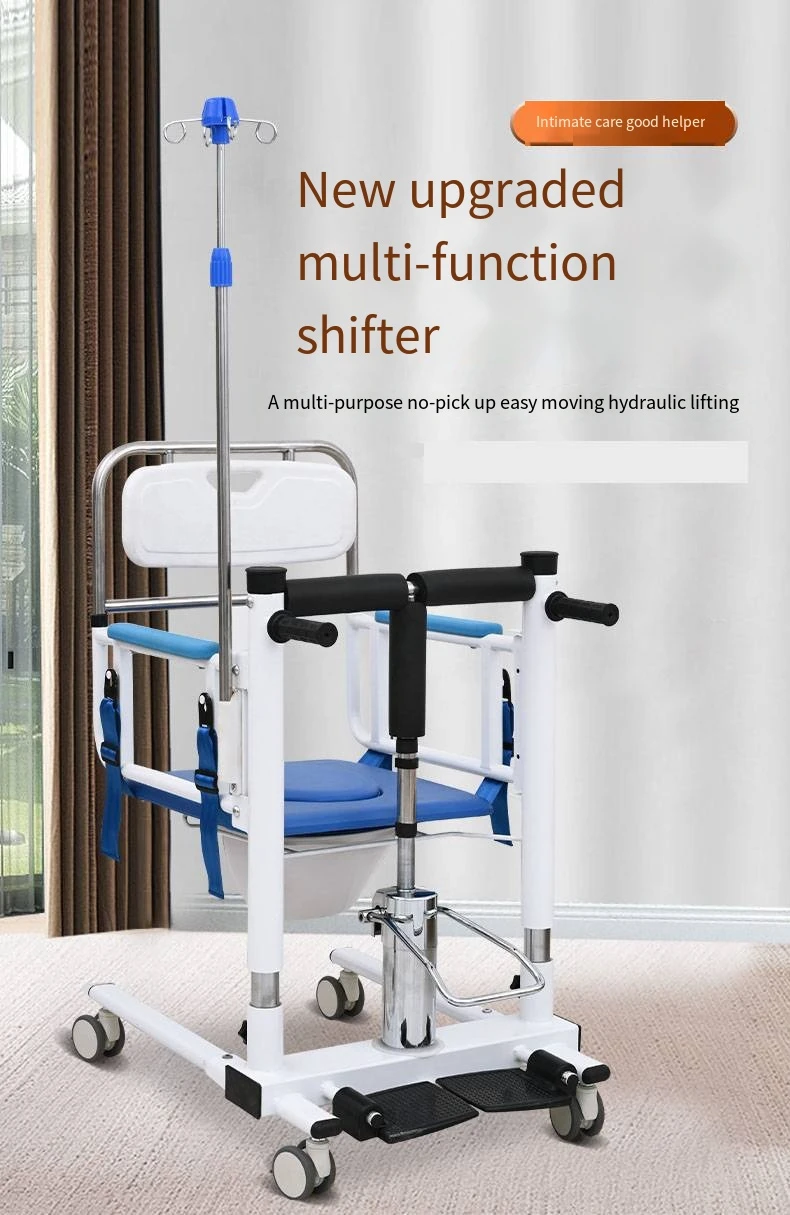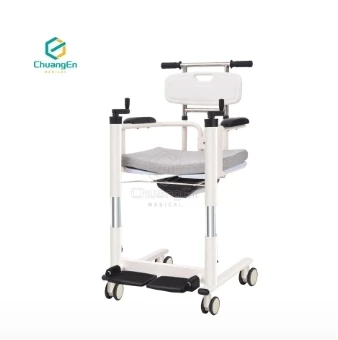The Indispensable Role and Evolution of Aluminum Underarm Crutches in Modern Mobility
In the realm of medical rehabilitation and personal mobility, the significance of assistive devices cannot be overstated. Among the most widely utilized and continuously refined tools are aluminum underarm crutches. These devices are crucial for individuals recovering from injuries, surgeries, or managing long-term mobility impairments. Their evolution from rudimentary wooden sticks to sophisticated, lightweight, and adjustable medical aids reflects profound advancements in material science, ergonomic design, and manufacturing precision. The modern iteration of the underarm crutch, primarily crafted from high-strength aluminum alloys, represents a pinnacle of engineering focused on enhancing user comfort, safety, and independence. The choice of aluminum as the primary material is not arbitrary; it offers an unparalleled combination of strength-to-weight ratio, corrosion resistance, and malleability, allowing for complex designs that cater to diverse anatomical needs. This section delves into the fundamental importance of these devices in daily living and healthcare, exploring how their design and material composition contribute significantly to improved patient outcomes and quality of life. Understanding the intricate balance between structural integrity and user comfort is paramount in the development of these essential mobility aids, ensuring they provide robust support while minimizing user fatigue and discomfort during prolonged use. The integration of advanced materials and manufacturing techniques has led to products that are not only durable but also aesthetically pleasing and highly functional, meeting the rigorous demands of both clinical environments and personal use.
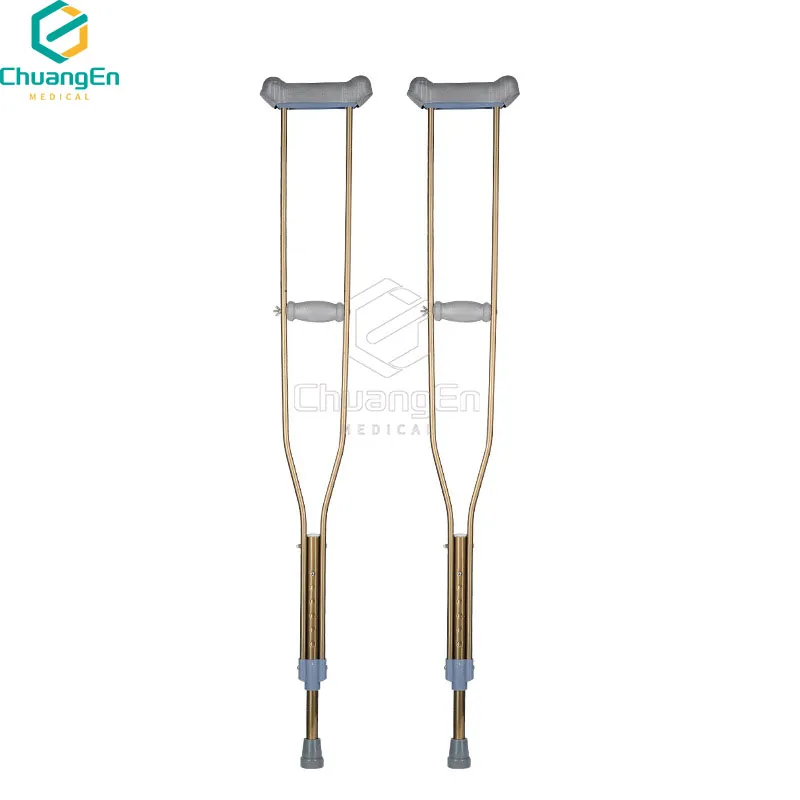
Historically, crutches were often cumbersome, heavy, and lacked the adjustability necessary for personalized fit, leading to secondary complications such as nerve damage or pressure sores. The shift to aluminum, specifically alloys like 6061 or 7075 aluminum, revolutionized their design. These alloys provide exceptional tensile strength and yield strength, ensuring the crutches can withstand significant vertical load-bearing capacity while remaining remarkably light. This reduced weight is a critical factor for users, as it lessens the energy expenditure required for ambulation, thereby facilitating faster rehabilitation and decreasing the likelihood of upper body strain or fatigue. Furthermore, the inherent corrosion resistance of aluminum, often enhanced through anodization, makes these crutches suitable for various environmental conditions, including humid or outdoor settings, without degrading their structural integrity or appearance over time. The telescopic design, a hallmark of modern aluminum crutches, allows for precise height adjustment to accommodate a wide range of user heights, promoting proper posture and biomechanics. This adjustability extends to the handgrip and underarm pad positions, ensuring ergonomic alignment that distributes pressure evenly and minimizes discomfort. The meticulous engineering behind each component, from the reinforced tips to the contoured pads, underscores a commitment to patient safety and functional efficacy. The continuous innovation in this sector aims to provide solutions that are not merely supportive but also empowering, enabling individuals to regain mobility and maintain an active lifestyle during their recovery journey. The widespread adoption of aluminum underarm crutches across hospitals, rehabilitation centers, and individual homes worldwide attests to their proven efficacy and reliability as essential tools for regaining and sustaining independence.
Industry Trends and Market Dynamics Shaping the Mobility Aid Sector
The global market for mobility aids, particularly those within the crutch segment, is experiencing robust growth driven by several demographic and technological trends. An aging global population, coupled with an increasing incidence of orthopedic injuries, chronic diseases, and non-communicable diseases requiring rehabilitative support, fundamentally fuels the demand for devices like aluminum underarm crutches. As life expectancy rises, so does the prevalence of conditions such as osteoporosis, arthritis, and diabetes-related complications that impair mobility. This demographic shift necessitates a greater availability of effective and user-friendly assistive devices. Furthermore, advancements in surgical techniques, particularly in orthopedic and reconstructive surgeries, often lead to a post-operative period requiring temporary or long-term mobility support, thereby sustaining demand for high-quality crutches. The market is also being shaped by a growing emphasis on home healthcare and independent living, prompting manufacturers to innovate products that are not only clinically effective but also portable, easy to use, and comfortable for extended periods outside of clinical settings. This push for independence also means that devices like the aluminum crutch must be adaptable to various environments, from indoor domestic use to outdoor activities.
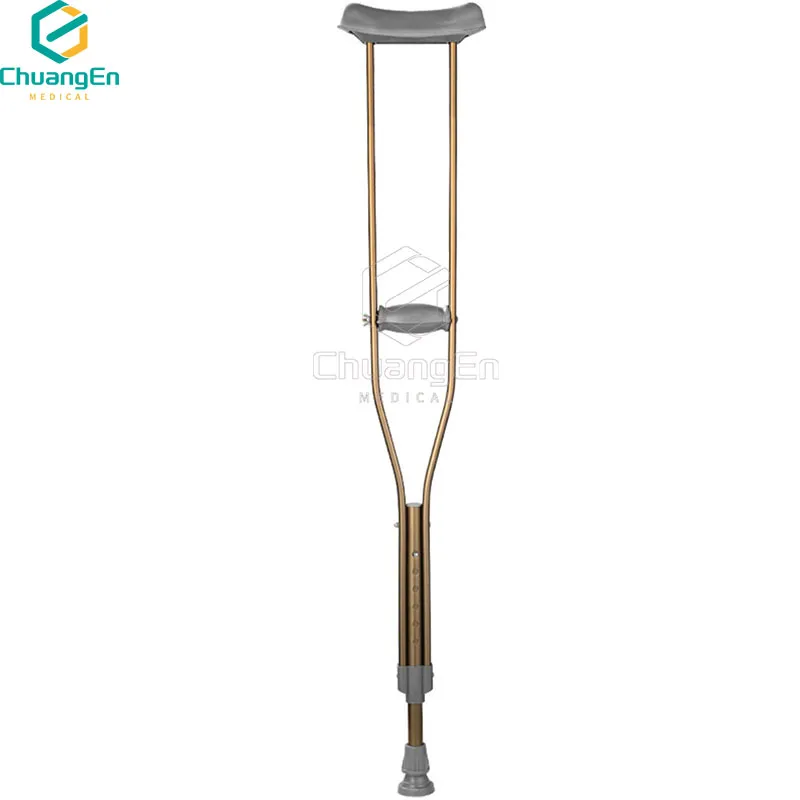
Technological advancements are profoundly influencing the design and functionality of mobility aids. Innovations include the development of ergonomic grips and axillary pads made from advanced composite materials, offering superior pressure distribution and ventilation to prevent skin irritation. The incorporation of telescopic mechanisms with quick-release buttons and precise height indicators simplifies adjustment and enhances user convenience. Moreover, smart features, though less common in basic crutches, are emerging in related mobility devices, hinting at future integrations that could provide gait analysis or fall detection. The trend towards lightweight materials, with aluminum leading the charge, continues to be a primary focus, as it directly impacts user compliance and reduces the physical burden of ambulation. Environmental consciousness is also influencing manufacturing, with a growing preference for recyclable materials and sustainable production processes. The competitive landscape is characterized by established medical device manufacturers, specialized mobility aid companies, and emerging players from Asian markets like China, which are increasingly offering cost-effective yet high-quality solutions, contributing to market accessibility. The convergence of these factors creates a dynamic market where continuous innovation in design, materials, and user-centric features is crucial for success. Manufacturers are increasingly focusing on customization and personalized fit, recognizing that a one-size-fits-all approach is insufficient for optimal patient care and comfort, propelling the evolution of adjustable and adaptable elderly crutches and other mobility aids.
Technical Parameters and Specifications: A Deep Dive into Aluminum Crutch Engineering
Understanding the technical parameters of aluminum underarm crutches is essential for healthcare professionals and end-users to ensure optimal performance, safety, and suitability for individual needs. The core of these specifications revolves around the materials used, structural dimensions, load-bearing capabilities, and ergonomic features. Typically, high-grade aluminum alloys such as 6061-T6 or 7075-T6 are preferred due to their excellent strength-to-weight ratio and resistance to fatigue. The "T6" temper designation indicates that the aluminum has undergone solution heat treatment and artificial aging, significantly enhancing its strength and hardness. This material choice allows for a robust yet lightweight frame, crucial for reducing user exertion. Key dimensions include the overall height adjustment range, which dictates suitability for different user heights (e.g., from 4'6" to 6'6"), and the adjustability of the handgrip position relative to the underarm support. These adjustment mechanisms often employ push-button or locking pin systems, designed for quick and secure changes. The shaft diameter and wall thickness are critical for structural integrity, with typical shaft diameters ranging from 1 inch to 1.25 inches. The load-bearing capacity, often specified in pounds or kilograms, indicates the maximum user weight the crutch can safely support. For instance, many standard axillary crutches are rated for users up to 300 lbs (approximately 136 kg), while bariatric models can support up to 500 lbs (approximately 227 kg).
Beyond structural integrity, ergonomic design plays a pivotal role. The underarm pads and handgrips are engineered to minimize pressure points and improve comfort. Materials such as dense foam, rubber, or advanced polymer composites are commonly used for these components, chosen for their cushioning properties, durability, and non-slip characteristics. The shape and contouring of these elements are designed to distribute pressure evenly, reducing the risk of nerve impingement (e.g., radial nerve palsy, often associated with poorly fitted or used crutches) and skin irritation, a common complaint among long-term crutch users. The crutch tips, made from durable, non-slip rubber compounds, are vital for traction on various surfaces and shock absorption. The diameter and tread pattern of these tips significantly impact stability and safety. Some advanced models may feature articulated or oversized tips for enhanced ground contact and stability on uneven terrain. The precise machining of interlocking parts, particularly in telescopic designs, ensures smooth adjustment and eliminates wobbling, contributing to overall user confidence. Manufacturers adhere to stringent international standards, such as ISO 11334 (Prostheses and orthoses — Structural testing of lower-limb prostheses and orthoses) and ANSI/RESNA (Rehabilitation Engineering and Assistive Technology Society of North America), to validate these parameters and ensure product safety and performance. This adherence to detailed specifications and quality control during manufacturing is what differentiates reliable crutches from inferior alternatives, guaranteeing that the product performs as expected under varied conditions of use, from light support to heavy load-bearing requirements, ensuring a safe and effective mobility solution.
Typical Specifications for CS-01H Medical Aluminum Alloy Telescopic Underarm Crutches
| Parameter | Specification for CS-01H | Typical Industry Range |
|---|---|---|
| Product Name | CS-01H Price cheap Medical Aluminum alloy telescopic underarm crutches for elderly | Various models (e.g., standard, bariatric, youth) |
| Material | High-strength 6061 Aluminum Alloy (T6 Temper) | 6061, 7075 Aluminum Alloy; occasionally steel or carbon fiber for specialized models |
| Height Adjustment Range | Small: 95-115cm; Medium: 115-135cm; Large: 135-155cm (approx. 37.4-61 inches) | Ranges to accommodate users from approx. 4'6" to 6'6" (137cm to 198cm) |
| Weight Capacity | Up to 135 kg (approx. 300 lbs) | Standard: 250-350 lbs (113-159 kg); Bariatric: 400-600 lbs (181-272 kg) |
| Crutch Weight (per pair) | Approx. 1.2 - 1.6 kg (2.6 - 3.5 lbs) depending on size | Typically 2-5 lbs (0.9-2.3 kg) per pair |
| Underarm Pad Material | Soft, durable rubber or high-density foam (replaceable) | Rubber, foam, gel, or silicone |
| Handgrip Material | Ergonomic, non-slip PVC/TPR (thermoplastic rubber) | Plastic, rubber, foam, or contoured composites |
| Crutch Tip Material | Non-skid, high-traction rubber with steel reinforcement | Non-slip rubber, often with wide base for stability |
| Adjustments | Push-button height adjustment, 9-level height adjustment, 4-level handgrip adjustment | Telescopic (push-pin), quick-release, or screw-lock mechanisms |
| Surface Treatment | Anodized finish for corrosion resistance and durability | Anodization, powder coating, polished finish |
| Compliance/Certifications | CE, ISO 13485 | FDA, CE, ISO 9001, ISO 13485, EN standards (e.g., EN 11334) |
The Advanced Manufacturing Process of Aluminum Underarm Crutches
The production of high-quality aluminum underarm crutches is a sophisticated multi-stage process that combines precision engineering with stringent quality control. It begins with the careful selection of raw materials, primarily high-grade aluminum alloys such as 6061 or 7075. These alloys are chosen for their superior mechanical properties, including high strength-to-weight ratio, excellent corrosion resistance, and good formability. The manufacturing process typically commences with aluminum extrusion, where aluminum billets are heated and forced through a die to create the tubular profiles that form the main shafts of the crutches. This process ensures consistent wall thickness and dimensional accuracy, critical for structural integrity and smooth telescopic operation. Following extrusion, the aluminum tubes undergo a heat treatment process, often to a T6 temper, which involves solution heat treatment followed by artificial aging. This step significantly increases the alloy's hardness, tensile strength, and yield strength, making the crutches robust enough to support significant weight without deforming. After heat treatment, the tubes are cut to specific lengths, depending on the crutch size (small, medium, large).
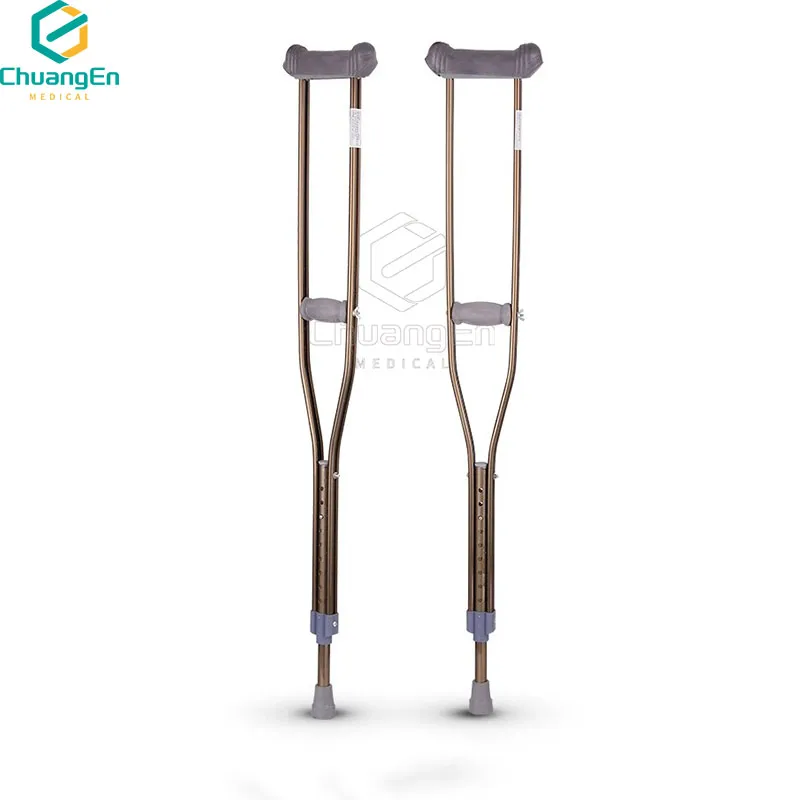
Subsequent stages involve precision machining, often utilizing Computer Numerical Control (CNC) equipment, to create the necessary holes for height adjustment pins, handgrip attachments, and other intricate features. CNC machining ensures unparalleled accuracy and repeatability, crucial for the smooth functioning of telescopic parts and secure locking mechanisms. After machining, the aluminum components undergo surface finishing, most commonly anodization. This electrochemical process creates a thin, durable, and corrosion-resistant oxide layer on the aluminum surface, which not only enhances the crutch's longevity and aesthetic appeal but also provides an additional layer of protection against scratches and environmental elements. Components like underarm pads, handgrips, and crutch tips are molded from high-quality rubber or polymer compounds. These are designed for optimal ergonomics, comfort, and non-slip performance. The assembly phase brings all these components together. This includes inserting the adjustable shafts, attaching the ergonomic handgrips and underarm pads, and securing the non-slip rubber tips. Each assembly step is often manually inspected to ensure proper fit and function. Throughout the entire manufacturing process, rigorous quality control (QC) checks are implemented at various stages. This includes material inspection upon arrival, dimensional checks after extrusion and machining, visual inspections after anodization, and functional testing during and after assembly.
Final product testing includes load-bearing capacity tests (static and dynamic), fatigue tests, and functional tests of adjustment mechanisms. Products must comply with international standards such as ISO 13485 (Medical devices — Quality management systems — Requirements for regulatory purposes) and relevant ANSI or EN standards for mobility aids (e.g., EN 11334-1: Walking aids — Part 1: General requirements and test methods). These standards dictate minimum performance criteria, safety features, and durability requirements, ensuring that each pair of crutches meets the highest levels of quality and safety for the end-user. The meticulous attention to detail in material selection, manufacturing processes like extrusion and CNC machining, surface treatments like anodization, and adherence to global inspection standards collectively ensures the production of superior aluminum underarm crutches. These processes contribute to an extended service life for the product, typically ranging from 5 to 10 years or more with proper care, depending on usage intensity. The applicable industries are predominantly medical and rehabilitation facilities, home healthcare providers, and individual consumers seeking reliable mobility support. The key advantage of these products in typical application scenarios, such as post-surgical recovery or long-term mobility assistance, lies in their lightweight nature, which reduces user exertion and promotes active rehabilitation, and their robust, anti-corrosion properties, ensuring longevity even in challenging environments. The energy efficiency aspect in this context translates to reduced physical effort for the user, indirectly contributing to faster recovery and improved quality of life.
Unpacking the Technical Advantages of Aluminum Underarm Crutches
The widespread adoption of aluminum underarm crutches over traditional materials stems from a comprehensive array of technical advantages that directly translate into superior user experience and clinical efficacy. Foremost among these is the exceptional strength-to-weight ratio of aluminum alloys. This metallurgical property means that these crutches can be remarkably lightweight while maintaining high structural integrity and load-bearing capacity. For the user, a lighter crutch significantly reduces the energy expenditure required for ambulation, leading to less fatigue in the shoulders, arms, and wrists. This is particularly beneficial for individuals undergoing long-term rehabilitation or those with limited upper body strength. Reduced weight also makes the crutches easier to maneuver, transport, and adjust, enhancing overall user independence. Another critical advantage is their corrosion resistance. Aluminum naturally forms a protective oxide layer when exposed to air, which can be further enhanced through anodization. This finish provides superior resistance to rust and degradation from moisture, sweat, and cleaning agents, extending the product's lifespan and maintaining its aesthetic appeal, even in demanding medical environments or varying climates. This property ensures hygienic use and reduces maintenance requirements.
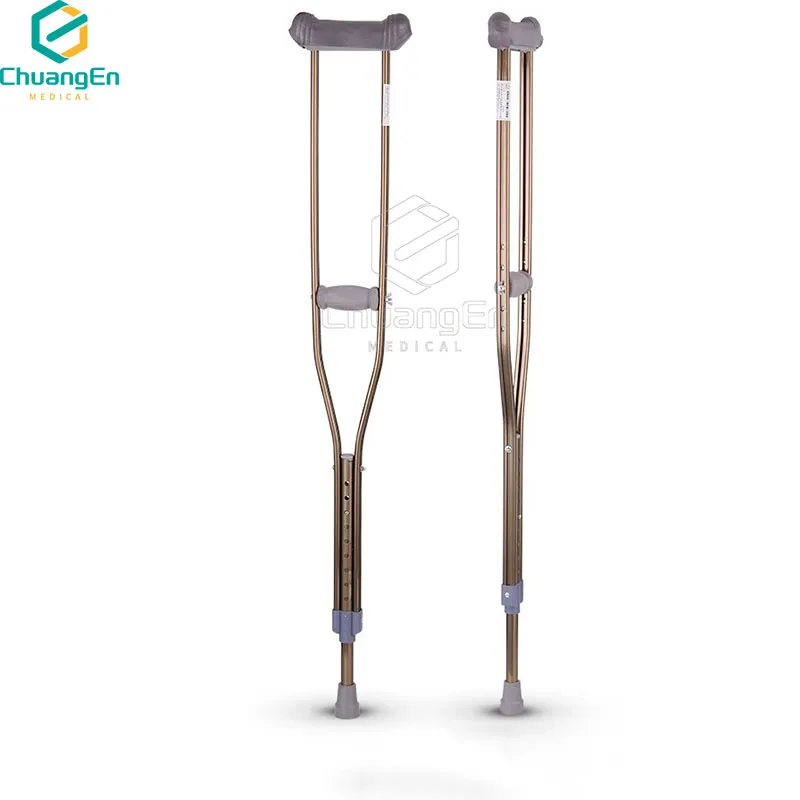
The adjustability and ergonomic design of aluminum crutches are also significant technical merits. Modern designs incorporate multi-level push-button height adjustments for both the overall crutch height and the handgrip position. This telescopic adjustability allows for a precise, customized fit for a wide range of user heights, promoting proper posture, reducing strain on the shoulders and back, and preventing common crutch-related injuries such as nerve compression. Ergonomically contoured underarm pads and handgrips, often made from soft yet durable rubber or foam, distribute pressure evenly across the contact points, minimizing discomfort, skin irritation, and the risk of pressure sores during prolonged use. The precise manufacturing techniques, including CNC machining, ensure that these adjustment mechanisms operate smoothly and lock securely, providing confidence and stability to the user. Furthermore, the inherent durability of heat-treated aluminum alloys ensures a long service life. Unlike wooden crutches that can splinter or warp, or steel crutches that are prone to rust and excessive weight, aluminum maintains its structural integrity over time, even with regular and vigorous use. This durability translates to a lower total cost of ownership for healthcare providers and individual users, as the need for frequent replacements is significantly reduced. The lightweight nature also implies less wear and tear on components, contributing to the overall longevity of the crutch stick.
Finally, the versatility in design and application of aluminum underarm crutches is a notable technical advantage. The malleability of aluminum allows manufacturers to produce various sizes and specialized models, including bariatric options with enhanced load capacities, pediatric sizes, and those with advanced features like shock absorption systems in the tips. This adaptability means that a single material type can cater to a broad spectrum of user needs and medical conditions, from short-term injury recovery to long-term mobility assistance. The ease of cleaning and sterilization, facilitated by the smooth, non-porous anodized surface, makes them ideal for clinical environments where hygiene is paramount. For example, the CS-01H model specifically addresses the needs of the elderly by offering lightweight support that reduces strain while maximizing stability, an essential feature for maintaining independence. These technical advantages collectively position aluminum crutches as the preferred choice in modern rehabilitation, offering a blend of safety, comfort, durability, and adaptability that is unmatched by other materials, significantly improving the quality of life for individuals requiring mobility support. The continuous research and development in materials science and biomechanics ensures that future iterations of these crutches will further refine these advantages, offering even greater user benefits.
Diverse Application Scenarios and Practical Use Cases for Aluminum Crutches
Aluminum underarm crutches are indispensable tools across a myriad of application scenarios, providing critical support and enhancing mobility for individuals facing diverse physical challenges. Their primary use is in medical rehabilitation, particularly after lower limb injuries such as fractures (e.g., tibia, fibula, ankle), sprains, or strains. They are routinely prescribed post-surgically following orthopedic procedures like knee or hip replacements, ACL reconstruction, or Achilles tendon repair. In these instances, crutches allow patients to maintain partial or non-weight-bearing status on the injured limb, facilitating healing and preventing further damage, while still enabling necessary ambulation. The adjustable nature of the aluminum crutch ensures that it can be precisely fitted by physical therapists, which is crucial for preventing compensatory gait patterns and secondary injuries. Beyond acute injury recovery, these crutches are vital for individuals with chronic conditions that affect mobility, such as osteoarthritis, cerebral palsy, multiple sclerosis, or spinal cord injuries. For these users, crutches offer long-term support, stability, and a means to maintain independence in daily activities, allowing them to navigate their homes, workplaces, and communities with greater confidence and reduced risk of falls.
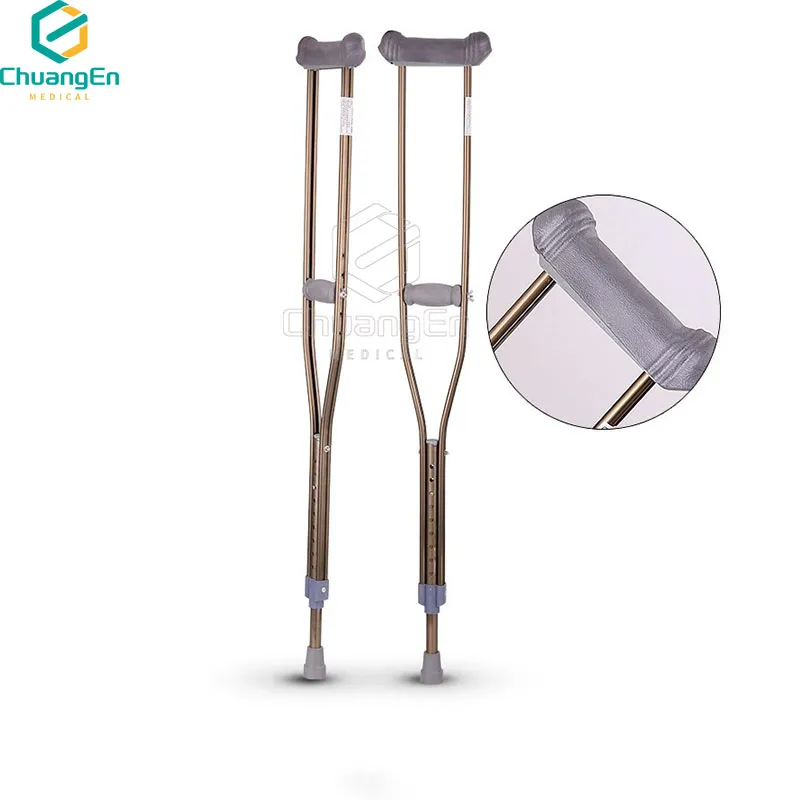
Another significant application scenario involves the elderly population. As age advances, balance and lower limb strength often diminish, increasing the risk of falls. Elderly crutches, especially lightweight aluminum models, provide the necessary stability and support to prevent falls, allowing seniors to maintain active lifestyles and autonomy. They serve as a reliable walking aid for individuals with age-related gait instability or those recovering from minor balance issues. In the context of sports medicine, crutches are commonly used by athletes to manage injuries sustained during training or competition. The lightweight and durable nature of aluminum allows athletes to safely manage their recovery period without compromising their future physical capabilities. Beyond the individual user, crutches are a staple in hospital and clinical settings, where they are readily available for patient discharge, emergency room visits for sprains or fractures, and as part of physical therapy programs. Their ease of cleaning and sterilization makes them suitable for high-turnover environments.
Furthermore, the versatility of the crutch cane and crutch stick variants extends their utility to scenarios where less comprehensive support is needed, or as a transition from full underarm crutch support. These variations offer targeted assistance, such as helping with balance or providing light weight-bearing support, making them suitable for individuals with minor gait disturbances or those in the final stages of rehabilitation. The lightweight property of aluminum makes it an ideal material for travel, enabling users to transport their crutches easily, facilitating mobility even when away from home. For example, a person recovering from a foot injury can still attend social events or travel for work with the support of a reliable and portable aluminum crutch. The practical applications are diverse, ranging from temporary support for acute injuries to long-term assistance for chronic conditions, consistently demonstrating their value in promoting independence, safety, and a better quality of life for millions worldwide. The adaptability of these devices ensures they remain a cornerstone of effective mobility assistance across varied demographics and medical requirements.
Manufacturer Comparison and Essential Selection Criteria for Aluminum Crutches
When sourcing aluminum underarm crutches, B2B buyers, including hospitals, rehabilitation centers, and medical distributors, face a critical decision in selecting the right manufacturer. The market is populated by numerous providers, each with varying levels of quality, specialization, and customer support. A thorough manufacturer comparison is paramount to ensure the procurement of high-performance, durable, and reliable products that meet both clinical needs and budget constraints. Key criteria for evaluating manufacturers include their certifications and compliance standards. Reputable manufacturers should possess international certifications such as ISO 9001 for quality management systems and, more importantly for medical devices, ISO 13485 for medical device quality management systems. Compliance with regulatory bodies like the FDA (U.S.) and CE marking (Europe) is non-negotiable for ensuring product safety and market entry. These certifications signify a manufacturer's commitment to consistent quality and adherence to stringent production and post-market surveillance protocols. Furthermore, a manufacturer's specialization in mobility aids often correlates with deeper expertise in ergonomic design, material science, and user-centric innovation, ensuring products like the axillary crutch are optimized for comfort and functionality.
The quality of materials and manufacturing processes is another distinguishing factor. Leading manufacturers utilize aerospace-grade aluminum alloys, rigorous extrusion processes, precision CNC machining, and advanced surface treatments like military-grade anodization, ensuring superior durability, strength, and corrosion resistance. Buyers should inquire about the specific alloy grades used (e.g., 6061-T6, 7075-T6) and the temper processes applied. A robust quality control system throughout the production chain, from raw material inspection to final product testing (including static load tests, dynamic fatigue tests, and tip abrasion resistance), indicates a manufacturer's dedication to product reliability. Product range and customization capabilities are also crucial. A manufacturer offering a comprehensive range of crutch sizes (pediatric, adult, bariatric) and adjustable features demonstrates a commitment to meeting diverse patient needs. The ability to offer tailored solutions, such as specific finishes, branding, or minor design modifications, can be a significant advantage for large buyers seeking unique product lines or specialized inventory.
After-sales support, warranty, and delivery logistics form the backbone of a reliable partnership. A reputable manufacturer will provide clear warranty terms, readily available spare parts (e.g., replacement tips, pads, handgrips), and responsive technical support. Efficient global supply chain management and flexible delivery options are vital for timely procurement. Finally, market reputation and client testimonials offer valuable insights into a manufacturer's reliability and product performance. Reviews from other B2B clients, industry awards, and long-standing partnerships can attest to a manufacturer's credibility. For instance, Chuangen Medical, with its CE and ISO 13485 certifications, exemplifies a manufacturer committed to these standards. When evaluating a potential supplier for crutch stick or any other mobility device, it is essential to consider the total value proposition, not just the unit price. Investing in a higher-quality product from a reputable manufacturer can lead to lower long-term costs due to increased durability, reduced replacement rates, and enhanced patient satisfaction, ultimately contributing to better clinical outcomes and operational efficiency within healthcare facilities. The choice of manufacturer directly impacts the safety and comfort of end-users, underscoring the importance of this meticulous selection process for all buyers.
Customization Solutions and Application Cases for Tailored Mobility
While standard aluminum underarm crutches cater to the majority of users, the increasing demand for personalized healthcare solutions has led to a growing emphasis on customization options. Tailoring mobility aids ensures optimal fit, comfort, and efficacy, particularly for patients with unique anatomical requirements, specific rehabilitation goals, or long-term mobility challenges. Customization can range from subtle modifications to significant structural alterations. One common area of customization involves sizing and adjustability beyond standard ranges. For exceptionally tall or short individuals, or those with unique limb proportions, manufacturers can produce crutches with extended or reduced height adjustment ranges, or even custom fixed heights if long-term use is anticipated and precise measurements are available. This ensures that the crutch maintains proper ergonomic alignment, preventing discomfort and secondary injuries that can arise from ill-fitting devices. Another key aspect is the selection and modification of contact points. Underarm pads and handgrips can be customized with various materials, densities, and contours. For example, individuals prone to nerve compression might benefit from gel-filled or extra-wide underarm pads designed to distribute pressure more broadly. Similarly, specialized handgrips can be provided for users with arthritis, carpal tunnel syndrome, or neurological conditions affecting grip strength, offering enhanced comfort and control.
Surface finishes and aesthetic customization are also gaining traction, particularly in the B2C market but also for institutions that wish to differentiate. Beyond standard anodized colors, custom powder coatings or graphic designs can be applied for personalization or to match institutional branding. While primarily aesthetic, durable custom finishes can also offer enhanced resistance to specific chemicals or environmental factors. For clinical environments, specific antibacterial coatings can be applied. Specialized crutch tips represent another area of customization. While standard rubber tips are effective, some users might benefit from specialized designs such as articulating tips for uneven terrain, extra-wide bases for enhanced stability, or even designs optimized for specific surfaces like ice or sand. These specialized tips improve safety and confidence in diverse environments. For instance, a patient living in a rural area with uneven outdoor surfaces would greatly benefit from crutches equipped with wide, flexible, and articulating tips, which adapt better to challenging terrains than standard narrow tips.
Application Cases demonstrating customization include: Pediatric Crutches for Growing Children: A child with cerebral palsy requires crutches that can be incrementally adjusted as they grow, with lightweight frames and smaller, softer contact points to prevent skin breakdown and accommodate their delicate bone structure. A manufacturer providing modular designs or easily replaceable components for size changes offers significant value. Bariatric Patients with Unique Support Needs: Obese patients require crutches with significantly higher weight capacities, reinforced tubing, and often wider bases for increased stability. Customization might involve wider, more robust frames and larger, more supportive underarm and handgrip pads to ensure safe and comfortable weight distribution. Athletes in Rehabilitation: A professional athlete recovering from a severe leg injury might require ultra-lightweight crutches made from advanced alloys or composites, possibly with integrated shock absorption to minimize impact on their upper body, enabling a faster and more comfortable return to training. Users with Specific Neurological Conditions: Individuals with conditions like Parkinson's disease, who may experience gait freezing or balance issues, could benefit from crutches equipped with integrated laser cues (projecting a line on the floor) to aid in gait initiation and rhythm, or specialized non-slip tips that provide immediate feedback on surface contact. These examples underscore how customization transforms a generic mobility aid into a highly effective, patient-specific solution, enhancing compliance, comfort, and ultimately, rehabilitation outcomes and long-term independence for users of crutches.
Ensuring Trustworthiness: Quality Assurance, Certifications, and Customer Support
For B2B stakeholders in the medical device industry, establishing trustworthiness with a manufacturer of aluminum underarm crutches is paramount. This trust is built upon a foundation of robust quality assurance processes, adherence to international certifications, transparent communication, and comprehensive customer support. A highly reputable manufacturer will implement a stringent Quality Management System (QMS) throughout every stage of production, from raw material sourcing to final product delivery. This QMS is typically compliant with ISO 9001 and, critically for medical devices, ISO 13485. ISO 13485 outlines requirements for a QMS where an organization needs to demonstrate its ability to provide medical devices and related services that consistently meet customer and applicable regulatory requirements. This includes meticulous documentation, risk management, design controls, supplier management, production and process controls, and post-market surveillance. Beyond ISO standards, compliance with specific market regulations such as FDA registration (U.S.) and CE marking (Europe) is non-negotiable for selling medical devices globally. These certifications demonstrate that the product has met rigorous safety, health, and environmental protection requirements. When a product like the CS-01H aluminum crutch carries such certifications, it signals to buyers that the product has undergone thorough evaluation and meets high standards for quality and safety.
Testing data and authoritative references further reinforce a manufacturer's trustworthiness. Manufacturers should be able to provide detailed test reports for key performance indicators, including static load-bearing capacity, dynamic fatigue testing, tip abrasion resistance, and corrosion resistance. These tests are often conducted by independent third-party laboratories, adding an extra layer of credibility. Providing empirical data, such as the number of cycles a crutch can withstand during fatigue testing (e.g., millions of cycles without structural failure), offers tangible proof of durability. Furthermore, partnerships with renowned medical institutions, long-standing service records (e.g., 10+ years in the industry), and testimonials from established healthcare providers collectively build a strong reputation for authority and reliability. For instance, if a manufacturer consistently supplies major hospital networks or contributes to rehabilitation research, it speaks volumes about their expertise and reliability. This type of authoritative backing goes beyond mere product claims, providing concrete evidence of product performance and manufacturer credibility for any crutch cane or mobility aid.
Trustworthiness through Transparency: FAQ, Delivery, Warranty, and Support
- FAQ Module for Common Queries: A comprehensive FAQ section is invaluable for addressing common questions regarding product specifications, usage, maintenance, and compatibility. For aluminum underarm crutches, typical FAQs might include: "What is the weight capacity of your crutches?", "How do I properly adjust the height?", "Are replacement parts available?", "What material are the crutch tips made of?", "How should I clean my crutches?". A well-structured FAQ demonstrates proactivity and transparency, saving time for both the buyer and the manufacturer by providing instant answers to frequent inquiries.
- Clear Delivery Cycle and Logistics: Transparency about lead times, shipping methods, and supply chain capabilities is crucial for B2B buyers who rely on timely inventory. Manufacturers should provide clear information on average delivery cycles, minimum order quantities (MOQ), and their ability to handle international logistics, including customs documentation. Real-time tracking capabilities and proactive communication about potential delays further build trust.
- Comprehensive Warranty Promise: A robust warranty policy reflects a manufacturer's confidence in their product's quality and durability. Details should include the duration of the warranty (e.g., 1-year limited warranty on structural components, 90 days on wear parts like tips and pads), what defects are covered, and the process for making a warranty claim. A commitment to addressing manufacturing defects instills confidence in the buyer.
- Responsive Customer Support and Technical Assistance: Availability of multiple contact channels (phone, email, live chat), trained support staff, and dedicated account managers are vital. Quick response times to inquiries, effective troubleshooting, and proactive post-sales follow-up demonstrate a commitment to customer satisfaction. For technical products like the crutches, expert technical assistance is invaluable for addressing complex queries or providing guidance on product integration and maintenance.
By adhering to these principles of quality assurance, obtaining relevant certifications, and providing comprehensive customer support, manufacturers not only meet regulatory obligations but also build long-term, trusting relationships with their B2B clients, ensuring that products like the aluminum underarm crutches continue to meet the highest standards of safety, performance, and reliability. This holistic approach to trustworthiness is what sets leading manufacturers apart in a competitive global market.
Conclusion: The Enduring Value of Advanced Aluminum Crutches
The journey through the intricate world of aluminum underarm crutches reveals a product that is far more than a simple mobility aid; it is a testament to the continuous innovation in material science, ergonomic design, and manufacturing precision within the medical device industry. From the careful selection of high-strength aluminum alloys, through advanced manufacturing processes such as extrusion, CNC machining, and anodization, to the rigorous quality control and adherence to international standards like ISO 13485, every aspect of these devices is engineered for optimal performance, safety, and user comfort. The inherent advantages of aluminum—its unparalleled strength-to-weight ratio, exceptional corrosion resistance, and adaptability for ergonomic design—have positioned these crutches as the gold standard in rehabilitation and long-term mobility support. They significantly reduce user fatigue, enhance stability, and withstand the rigors of daily use across diverse environments, from hospital wards to outdoor terrains.
The market for crutches, including specialized elderly crutch and axillary crutch variants, continues to expand, driven by an aging global population and a rising incidence of musculoskeletal injuries and chronic conditions. This growing demand fuels innovation in customization, allowing for tailored solutions that address unique patient needs, from specific sizing requirements to specialized contact points and aesthetic preferences. For B2B buyers, the ability to discern high-quality manufacturers based on their certifications, testing protocols, and robust customer support systems is crucial for ensuring the procurement of reliable, durable, and safe products. A manufacturer committed to transparent practices, comprehensive warranties, and efficient logistics builds long-term trust and contributes to better patient outcomes.
Ultimately, the value proposition of modern aluminum underarm crutches lies in their profound impact on user independence and quality of life. By providing stable, comfortable, and reliable support, they empower individuals to navigate their recovery journeys or manage chronic mobility impairments with greater confidence and reduced physical burden. As technology advances and understanding of biomechanics deepens, the future of these essential mobility aids promises even greater refinements, further solidifying their indispensable role in global healthcare and personal well-being. The continuous pursuit of excellence in this sector underscores a commitment to enhancing human mobility and fostering greater independence for all.
References and Further Reading
- World Health Organization. (2023). "Assistive technology." Retrieved from https://www.who.int/news-room/fact-sheets/detail/assistive-technology
- Physiopedia. (n.d.). "Crutches." Retrieved from https://www.physio-pedia.com/Crutches
- ISO. (n.d.). "ISO 13485: Medical devices — Quality management systems — Requirements for regulatory purposes." Retrieved from https://www.iso.org/standard/59752.html
- Rehabilitation Engineering and Assistive Technology Society of North America (RESNA). (n.d.). "Standards & Recommended Practices." Retrieved from https://www.resna.org/knowledge-center/standards-and-recommended-practices

